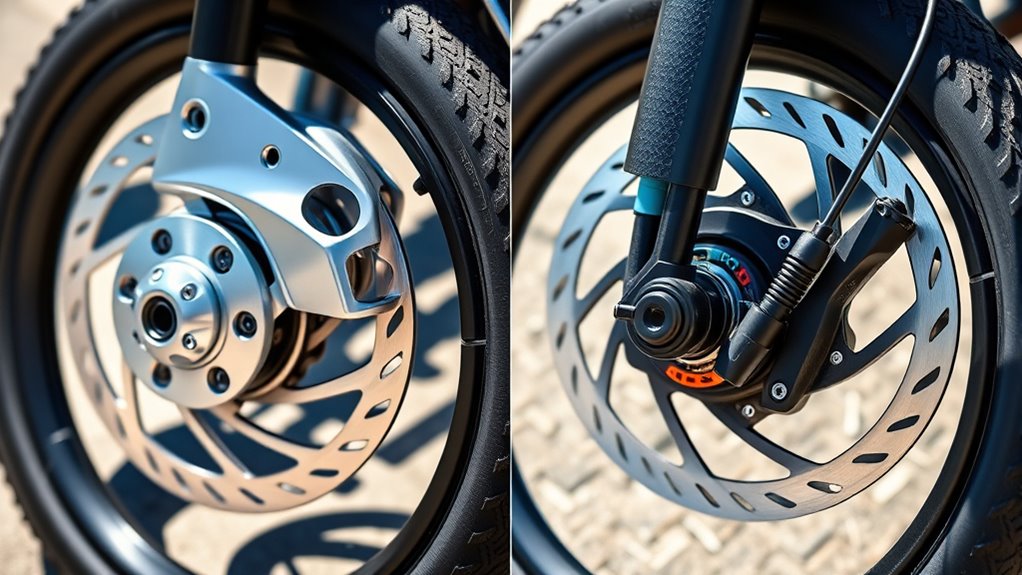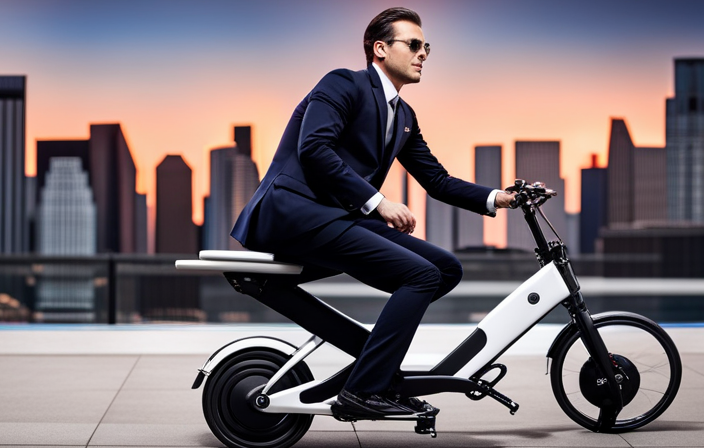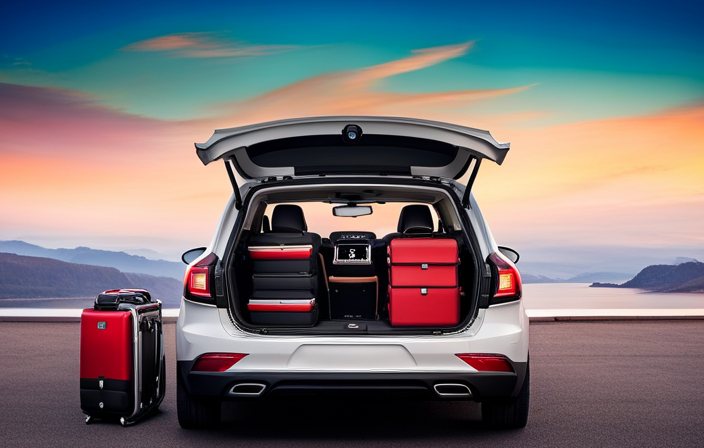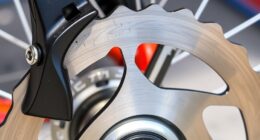Hydraulic disc brakes provide smooth, powerful stopping with better performance in wet conditions and require more maintenance and higher upfront costs. Mechanical brakes are simpler, easier to adjust, and cheaper initially but may need frequent tweaks and less consistent performance. Both have pros and cons depending on your riding style, terrain, and maintenance preferences. For a deeper understanding of which system suits you best, explore the full guide for detailed insights.
Key Takeaways
- Hydraulic brakes offer smoother, more consistent stopping power, especially in wet or muddy conditions, compared to mechanical brakes.
- Mechanical brakes are simpler, cheaper to install, and easier to maintain but may require frequent adjustments.
- Hydraulic systems generally have higher initial costs but provide better durability and long-term value.
- Mechanical brakes depend on cable tension, which can lead to spongy feel or reduced efficiency if not properly maintained.
- Proper selection depends on terrain, maintenance willingness, and performance needs, as each system has distinct advantages and limitations.
How Hydraulic and Mechanical Disc Brakes Work

Hydraulic and mechanical disc brakes operate through different mechanisms to slow or stop your bike. When you squeeze the brake lever on hydraulic brakes, it pushes hydraulic fluid—like mineral oil or DOT fluid—through hoses to actuate a piston that presses the brake pads against the rotor. The brake pad materials, such as resin or metallic compounds, influence braking performance and noise. Mechanical brakes, on the other hand, use a cable connected to the lever; pulling it pulls the cable, which moves the brake caliper and forces the pads onto the rotor. Hydraulic fluid types vary in viscosity and compatibility, affecting responsiveness and maintenance. Both systems rely on proper brake pad materials to ensure effective stopping power and durability, but they operate through distinct mechanisms that influence feel and performance. Additionally, performance upgrades such as high-quality brake pads or upgraded calipers can further enhance braking efficiency and modulation.
Advantages and Disadvantages of Hydraulic Brakes

Hydraulic disc brakes offer several advantages that make them a popular choice for both casual riders and serious cyclists. Their braking power is impressive, providing smooth, consistent stops even in wet or muddy conditions. This makes them highly reliable and safe for various terrains. However, installation challenges can be a drawback. Hydraulic systems require more complex setup and bleeding procedures, which may be intimidating if you’re not experienced. Maintenance can also be more demanding, needing regular checks to ensure no leaks and proper fluid levels. Despite these challenges, many riders appreciate the precise control and strong stopping force hydraulic brakes deliver. Overall, if you’re willing to invest time or seek professional help, hydraulic brakes can substantially enhance your riding experience. Proper maintenance is essential to keep hydraulic brakes functioning optimally over time.
Benefits and Limitations of Mechanical Brakes

Mechanical disc brakes are a straightforward and reliable option for cyclists who prefer a simple braking system. They offer easy installation and are generally more affordable upfront. However, their benefits come with some limitations. Over time, brake pad wear can require more frequent replacements, affecting braking performance. Maintaining consistent cable tension is vital; if the cable slackens, braking efficiency drops, and you might need to readjust it. Mechanical brakes are less sensitive to temperature changes than hydraulic systems, but they can feel less powerful, especially in wet conditions. Additionally, their reliance on mechanical parts means you might experience more play or sponginess in the brake lever. Still, if simplicity and ease of repair appeal to you, mechanical disc brakes remain a practical choice.
Maintenance and Repair Considerations for Each System

Maintaining and repairing disc brakes requires different approaches depending on the system you choose. For hydraulic brakes, you’ll need to regularly check and replace brake fluid to prevent contamination and guarantee smooth operation. Mechanical brakes, on the other hand, mainly demand caliper alignment to keep braking responsive. Here are key considerations:
- Bleeding hydraulic brakes to remove air and maintain brake fluid quality.
- Replacing or topping up brake fluid as needed.
- Ensuring calipers are properly aligned for ideal contact.
- Inspecting brake pads and replacing them when worn.
- Be aware that home security systems can influence your sense of safety while working on your bike or in your garage, especially if you’re performing maintenance late at night or in secluded areas.
Hydraulic systems are more sensitive to fluid issues, while mechanical systems rely on precise caliper positioning. Both systems require regular attention to keep your braking reliable and safe.
Cost Differences and Long-Term Value

Are you wondering which disc brake system offers better long-term value? The answer depends on your budget and durability factors. Hydraulic brakes often have a higher initial price comparison, but they tend to last longer and require less maintenance. Mechanical brakes are generally cheaper upfront but may need more frequent adjustments and replacements. Over time, the durability of hydraulic systems can offset their higher cost, providing better value. Additionally, the choice between the two can impact the overall home decor of your cycling setup, blending functionality with aesthetics. To help you compare, here’s a quick overview:
Which Braking System Is Right for Your Riding Style

Your riding terrain and how you ride can influence which braking system suits you best. Consider whether you need quick, reliable stopping power for hilly trails or smoother, low-maintenance control for flat roads. The right choice depends on balancing your terrain, maintenance preferences, and performance needs. Additionally, understanding the design principles behind each system can help you make an informed decision to enhance your cycling experience.
Riding Terrain Compatibility
When choosing between hydraulic and mechanical disc brakes, understanding how each system performs on different terrains is essential. If you mainly ride mountain trails, hydraulic brakes offer consistent stopping power, even on steep descents and muddy conditions. For urban commuting, mechanical brakes are reliable and easier to repair on the go. Consider these points:
- Mountain trails demand powerful, fade-resistant braking—hydraulics excel here.
- Urban riding benefits from mechanical brakes’ straightforward maintenance.
- Technical descents require precise modulation—hydraulics provide smoother control.
- Short, stop-and-go commutes favor mechanical systems’ quick adjustments.
- Proper brake system selection can extend your bike’s lifespan and improve safety in various environments.
Matching your terrain with your brake type ensures safer, more efficient riding tailored to your environment.
Maintenance and Performance
Choosing between hydraulic and mechanical disc brakes depends heavily on your maintenance preferences and riding style. Hydraulic brakes generally require less frequent brake pad replacement and benefit from system bleeding to maintain ideal performance. Mechanical brakes, however, are easier to service and adjust on the go, which suits casual riders or those who prefer DIY maintenance.
| Maintenance Aspect | Hydraulic Brakes | Mechanical Brakes |
|---|---|---|
| Brake pad replacement | Less frequent, more complex | Easier, more accessible |
| System bleeding | Necessary for ideal performance | Rarely needed, simpler to do |
Frequently Asked Questions
How Do Hydraulic and Mechanical Disc Brakes Perform in Extreme Weather Conditions?
Hydraulic disc brakes generally perform better in extreme weather, thanks to their better corrosion resistance and consistent stopping power, even in icy conditions. They handle ice performance more reliably because their sealed systems prevent water and debris from affecting brake fluid. Mechanical brakes can struggle with corrosion and freezing, leading to reduced responsiveness. So, if you ride in harsh weather, hydraulic brakes offer more dependable performance and durability.
Can I Switch Between Hydraulic and Mechanical Disc Brakes on My Bike?
You can switch between hydraulic and mechanical disc brakes, but you need to check brake system compatibility first. Not all bikes are designed for both types, and upgrades might require new rotors, calipers, or levers. Consider your bike’s frame and fork compatibility, and be prepared for potential adjustments or parts replacements. It’s best to consult your bike’s manufacturer or a professional mechanic to guarantee a smooth transition.
What Are the Environmental Impacts of Manufacturing Hydraulic Versus Mechanical Brakes?
You should know that hydraulic brakes often have a higher environmental impact during manufacturing due to complex processes and eco-friendly materials use. They require more resources for sustainable manufacturing, which can lead to greater carbon footprints. Mechanical brakes typically involve simpler, more eco-friendly materials and processes, making them a greener choice overall. Choosing mechanical brakes can reduce your bike’s environmental footprint, especially if sustainability and eco-friendly materials matter to you.
Are There Specific Bike Types That Benefit More From One Brake System?
You’ll find that mountain bikers often benefit more from hydraulic brakes, as they handle rough terrain better and provide stronger stopping power. Meanwhile, for urban commuting, mechanical disc brakes are a solid choice due to their simplicity and easier maintenance. Don’t put all your eggs in one basket—choose the brake system that aligns with your riding style to get the most out of your bike.
How Do Brake Pad Replacement Intervals Compare Between Hydraulic and Mechanical Systems?
You’ll likely find that mechanical disc brakes need more frequent brake pad replacements due to shorter brake pad longevity, often every 500-1000 miles, depending on riding conditions. Hydraulic systems typically boast longer intervals, around 1500-3000 miles, thanks to better heat dissipation and consistent pressure. This means less maintenance frequency for hydraulic brakes, but keep an eye on pad wear to avoid decreased braking performance.
Conclusion
Now that you understand the strengths and quirks of hydraulic and mechanical disc brakes, the choice isn’t clear-cut. Think about your riding style—will you crave precision on steep descents or simplicity on daily commutes? The decision could change your entire experience on the trail or city streets. Whichever you pick, one thing’s certain: the right brake system could transform your ride—and the unexpected awaits just around the bend. Are you ready to find out what’s next?








